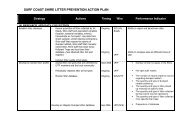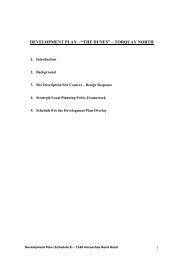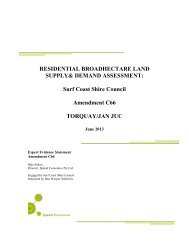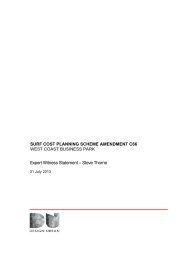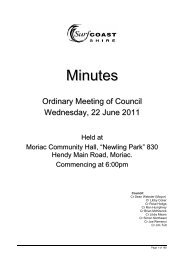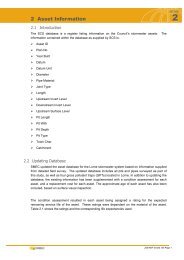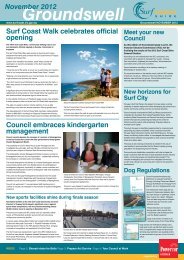Rural Strategy - Surf Coast Shire
Rural Strategy - Surf Coast Shire
Rural Strategy - Surf Coast Shire
Create successful ePaper yourself
Turn your PDF publications into a flip-book with our unique Google optimized e-Paper software.
<strong>Surf</strong> <strong>Coast</strong> <strong>Shire</strong> <strong>Rural</strong> <strong>Strategy</strong> Review<br />
Final Report<br />
6.4 State Policy<br />
The State Planning Policy Framework at Clause 16.03 <strong>Rural</strong> living and rural residential<br />
development provides clear guidelines for implementation of the <strong>Rural</strong> Living and Low<br />
Density Residential Zones. The clause states that land should only be zoned for rural living<br />
or rural residential development where it:<br />
Is located close to existing towns and urban centres, but not in areas that will be required<br />
for fully serviced urban development.<br />
Can be supplied with electricity and water and good quality road access.<br />
Land should not be zoned for rural living or rural residential development if it will<br />
encroach on high quality productive agricultural land or adversely impact on waterways or<br />
other natural resources.<br />
Further guidance for rural residential development is outlined in Ministerial Direction No. 6<br />
6.4.1 Ministerial Direction 6 – <strong>Rural</strong> Residential Development<br />
Ministerial Direction No. 6 seeks to ensure that a new rural residential development is a<br />
sustainable use of the land. In order to amend a planning scheme to provide for rural<br />
residential use through application of the <strong>Rural</strong> Living Zone, a Council must demonstrate<br />
that the proposed development:<br />
Is consistent with the housing and settlement strategy of the area;<br />
Is supported by and supports sustainable and viable settlements and communities;<br />
Does not compromise the sustainable future use of existing natural resources, including<br />
productive agricultural land, water, mineral and energy resources;<br />
Protects existing visual and environmental qualities for the area, such as landscape,<br />
water quality, native vegetation, habitat and biodiversity values;<br />
Avoids predictable adverse environmental processes and effects such as flooding,<br />
erosion, landslip, salinity or wildfire; and<br />
Can efficiently be serviced by social and physical infrastructure, at an acceptable and<br />
sustainable community cost.<br />
Ministerial Direction No.6 seeks to address some of the negative impacts of rural living such<br />
as:<br />
<strong>Rural</strong> living is an inefficient use of land to accommodate growth with fewer persons<br />
accommodated per hectare of land compared to urban settlement.<br />
<strong>Rural</strong> living is often supplied in a format encircling urban centres which, tends to<br />
perpetuate urban sprawl rather than create distinct green breaks between towns and<br />
rural areas.<br />
<strong>Rural</strong> living is more costly per household with regard to provision of services and<br />
infrastructure including roads, garbage collection and community facilities compared to<br />
more densely established settlements.<br />
RMCG Consultants for Business, Communities & Environment Page 31



